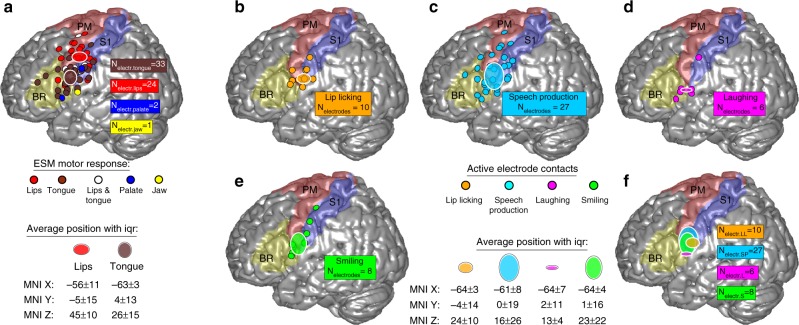Fig. 1.
Electrode contacts positions with (a) mouth motor function and with (b–f) event-related gamma power modulation. a Circles indicate the individual electrode contacts positions with mouth motor function (according to the results of the ESM) of all six participants, superimposed on a standard brain. The respective mouth-related body parts are colour-coded as following: the lips (red), the tongue (brown), the palate (blue) and the jaw (yellow). The number of electrode contacts with the respective ESM motor response is listed as Nelectr_motor_function. Ellipsoids indicate average positions of electrode contacts with lips (red-white) or tongue (brown-white) motor function; with the centre and size of the ellipsoids indicating the median and interquartile range of coordinates from the respective electrode contacts in MNI space. Exact values are listed beneath the figure, the respective MNI y- and z-coordinates are shown graphically. The typical extent of premotor cortex (PM; red area), primary somatosensory cortex (S1; blue area) and Broca’s area (BR; yellow area) are shown based on the anatomical probability information of the SPM Anatomy Toolbox. b–e Overview of significant (sign test; p < 0.01) event-related gamma power modulation within the ESM-defined mouth motor cortex, superimposed on a standard brain surface with the number of active electrode contacts listed as Nelectr_event. Small coloured dots indicate active electrode contacts, i.e., contacts that recorded significant movement-related gamma power modulations in the respective movement class. Large ellipsoids are centred at the average position (median over electrode contacts) and are scaled proportional to the interquartile range as a measure of spatial variance of the MNI y- and z-coordinates. Exact MNI coordinates are listed between (e) and f. Ellipsoids are overlaid for all movement classes in the bottom right panel (f) for a better overview. ESM electrocortical stimulation mapping

